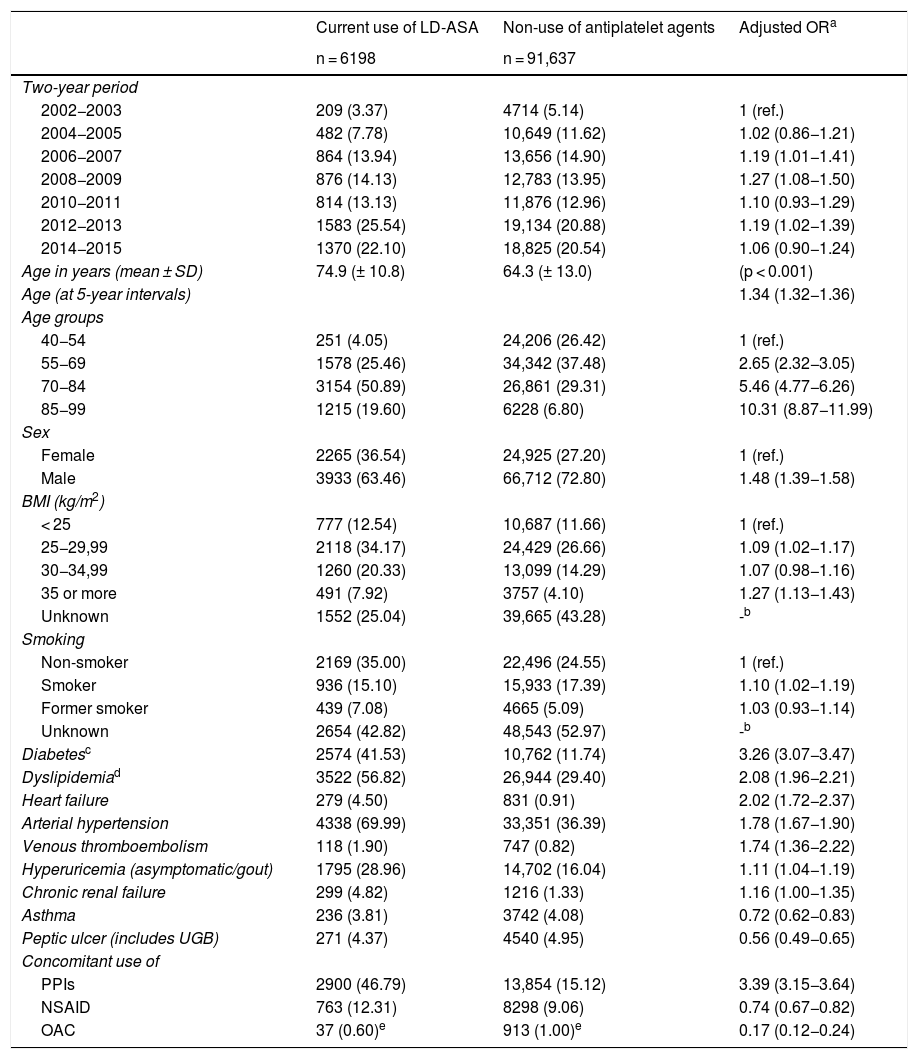The use of low-dose acetylsalicylic acid (LD-ASA) in primary prevention is a matter of controversy, but its magnitude is unknown in Spain. The aim of the study was to estimate the proportion of patients who are prescribed LD-ASA for primary prevention and to identify their characteristics.
MethodsIn a sample from the primary care database BIFAP we obtained the proportion of persons with prescriptions of LD-ASA over the period 2002–2015, excluding patients with any previous record of occlusive vascular disease, atrial fibrillation or cancer. The proportions were standardized to the Spanish population aged 40–99 years old. We identified the factors associated with the use of LD-ASA through a logistic regression and estimated its prevalence of use according to the presence of such factors.
ResultsThe sample included 102,850 subjects; of which 6198 were users of LD-ASA. The standardized prevalence of prescription was 2.21% at the start of the period and 3.57% at the end, and increased with age. The factors with the strongest associations were diabetes (OR = 3.26; 95% CI:3.07−3.47), dyslipidaemia (OR = 2.08;1.96−2.21), heart failure (OR = 2.02;1.72−2.37), and hypertension (OR = 1.78;1.67−1.90). Among diabetic patients older than 70 years with hypertension and dyslipidaemia, the prevalence of LD-ASA prescription was 33.7%.
ConclusionsThe prescription of LD-ASA for primary prevention in Spain over the study period was low in the general population, but high in older diabetic patients with additional risk factors. After years of controversy, it is time to realign the use of this drug in primary prevention according to recent guidelines.
El uso del ácido acetilsalicílico a dosis bajas (AAS-DB) en prevención primaria es motivo de controversia, pero se desconoce su magnitud en España. El objetivo del estudio fue estimar la proporción de pacientes a los que se prescribió AAS-DB como prevención primaria durante el periodo 2002–2015 e identificar sus características.
MétodosEn una muestra de la base de datos de atención primaria BIFAP se obtuvo la proporción de personas con prescripciones de AAS-DB, excluyendo los pacientes con enfermedad vascular oclusiva, fibrilación auricular y cáncer. Las proporciones se estandarizaron para la población española de 40–99 años. Se construyó un modelo de regresión logística para identificar los factores asociados a la prescripción de AAS-DB y se estimó su prevalencia según la combinación de dichos factores.
ResultadosSe incluyeron 102.850 sujetos, 6.198 de ellos usuarios de AAS-DB. La prevalencia estandarizada fue del 2,21% al comienzo del periodo y del 3,57% al final. La prescripción aumentó con la edad. Los factores más asociados fueron diabetes (OR = 3,26;IC95%:3,07−3,47), dislipemia (OR = 2,08;1,96−2,21), insuficiencia cardiaca (OR = 2,02;1,72−2,37), e hipertensión (OR = 1,78;1,67−1,90). La prevalencia de prescripción de AAS-DB alcanzó el 33,7% en mayores de 70 años con diabetes, hipertensión y dislipemia.
ConclusionesEn el periodo estudiado, la prescripción de AAS-DB para prevención primaria en España fue baja en la población general, pero elevada en pacientes diabéticos mayores de 70 años con factores de riesgo adicionales. Después de años de controversia, parece necesario adecuar el uso de este fármaco en prevención primaria a las recomendaciones actuales.












